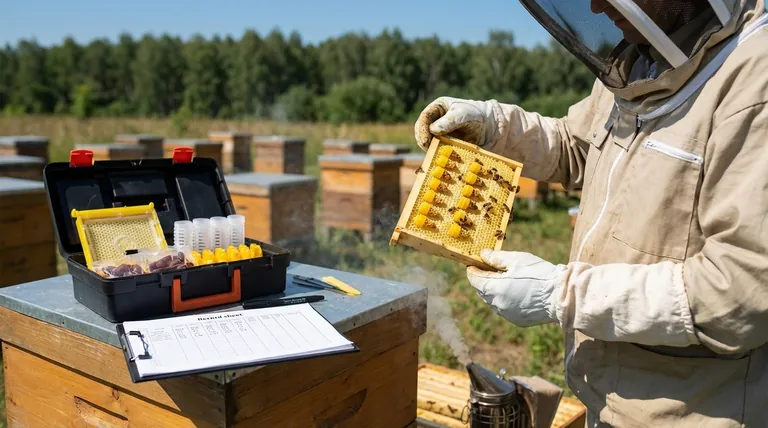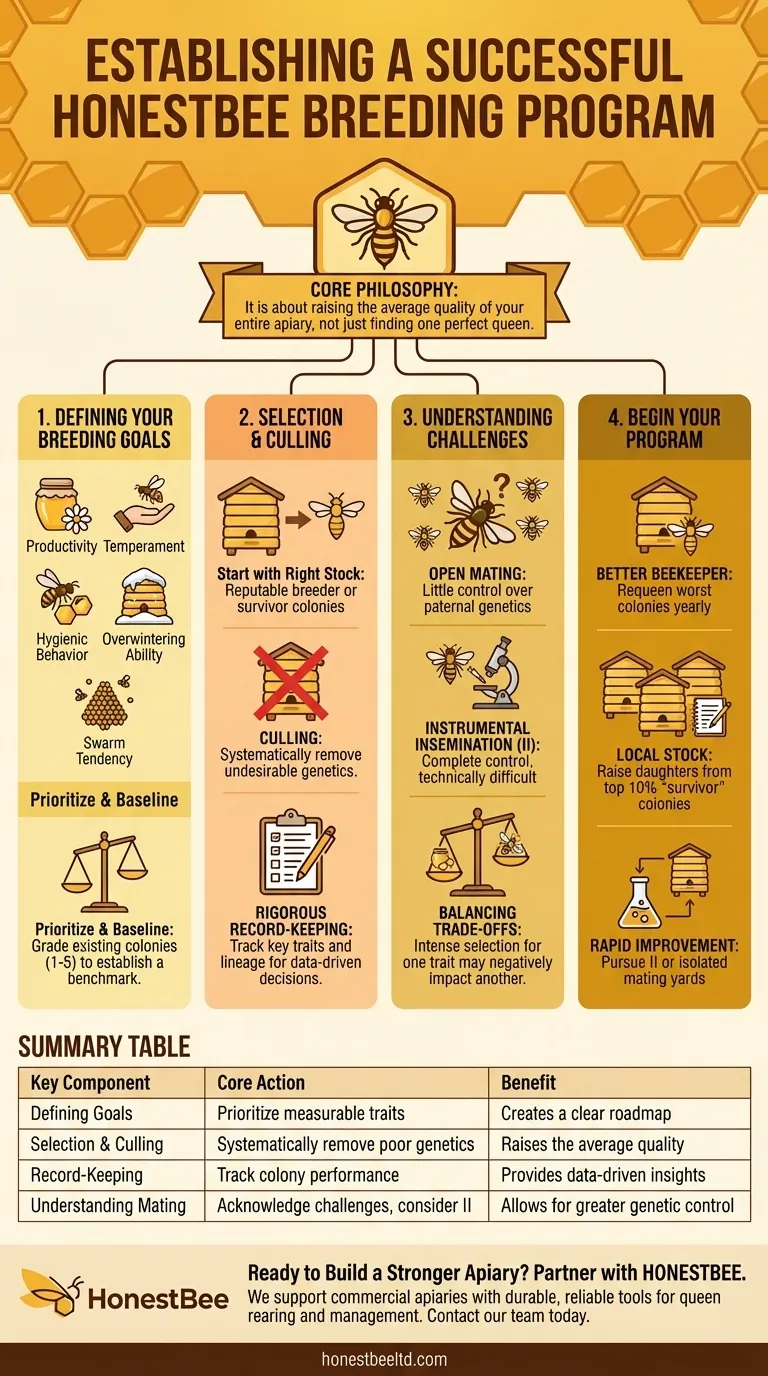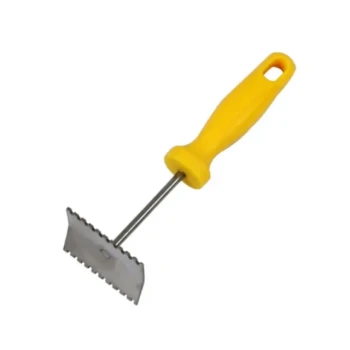To establish a successful honey bee breeding program, you must combine clear, measurable goals with a disciplined process of selection and culling. It is a long-term commitment that requires diligent record-keeping, a solid understanding of honey bee biology, and the dedication to systematically improve your stock generation after generation.
The core of successful honey bee breeding is not about finding one perfect queen. It is about raising the average quality of your entire apiary by consistently removing the worst-performing genetics and propagating the best.

The Foundation: Defining Your Breeding Goals
A breeding program without clear goals is merely a series of random decisions. Before you begin selecting, you must define what a "better bee" means for your specific operation and environment.
Identifying Key Traits
Your program must focus on a few measurable traits. Common and valuable traits for selection include:
- Productivity: Honey and pollen production.
- Temperament: Selecting for gentle, non-defensive bees makes them safer and more enjoyable to manage.
- Hygienic Behavior: The ability of workers to detect and remove diseased or parasitized brood, which confers natural resistance to pests like Varroa mites and diseases like chalkbrood.
- Overwintering Ability: The capacity for a colony to survive the winter with minimal resource consumption and a healthy population in the spring.
- Swarm Tendency: Selecting for a lower tendency to swarm reduces management work and prevents the loss of your workforce.
Prioritizing for Your Operation
You cannot select for everything at once. A commercial honey producer might prioritize productivity above all, while a backyard beekeeper might value gentleness and low swarm tendency most highly. Be realistic about what matters most to you.
Establishing a Baseline
You cannot measure improvement without knowing your starting point. Begin by grading your existing colonies on a simple scale (e.g., 1-5) for each of your chosen traits. This initial data is the benchmark against which all future progress is measured.
The Engine of Improvement: Selection and Culling
Once you have your goals, the work of selection begins. This process is about influencing which genetics are passed on to the next generation.
Starting with the Right Stock
You have two primary options for sourcing your initial genetics. You can purchase queens with known, desirable traits from a reputable breeder, or you can identify the best-performing "survivor" colonies within your own existing stock.
The Principle of Culling
Culling—the systematic removal of undesirable genetics—is the most powerful tool in a breeding program. This means you must be willing to requeen or entirely remove colonies that exhibit unacceptable traits, such as extreme defensiveness, high disease loads, or poor productivity. By preventing the worst colonies from producing drones and queens, you shift the genetic average of your entire apiary upward.
Rigorous Record-Keeping
Your memory is not a reliable tool. A simple, consistent record-keeping system is non-negotiable. Track the key traits for each colony, its queen's lineage, and any management actions taken. These records are the data that will drive your selection decisions.
Understanding the Trade-offs and Challenges
Honey bee breeding is uniquely complex. Understanding the inherent difficulties is crucial for setting realistic expectations and avoiding frustration.
The Challenge of Open Mating
A queen bee's genetics are only half of the equation. She typically mates with 10-20 different drones in mid-air, far from the hive. This open mating means that unless your apiary is in a very isolated area, you have little control over the paternal side of your colony's genetics. Your queens may be mating with drones from your neighbors' unselected, and potentially undesirable, colonies.
The Role of Instrumental Insemination
Instrumental insemination (II) is the advanced solution to the open mating problem. It allows for complete control over mating by manually inseminating a virgin queen with semen collected from specific drones. While II provides the fastest and most precise genetic progress, it is a technically difficult and expensive skill to master, often reserved for serious commercial or academic programs.
Balancing Competing Traits
Be aware that selecting intensely for one trait can sometimes have a negative impact on another. For example, some lines of extremely hygienic bees may be less productive, or highly productive bees may be more defensive. A successful program requires finding a sustainable balance among your desired traits.
How to Begin Your Breeding Program
Your approach should match your experience level and goals. The key is to start simple and build complexity as you gain confidence.
- If your primary focus is becoming a better beekeeper: Start by simply identifying your worst 1-2 colonies each year and requeening them with a queen from a reputable breeder. This is the first step in active selection.
- If your primary focus is creating locally adapted stock: Implement a formal record-keeping system for all your hives. Identify your top 10% "survivor" colonies—those that thrive with minimal intervention—and use them to raise your own daughter queens.
- If your primary focus is rapid, targeted genetic improvement: Pursue instrumental insemination or collaborate with other local breeders to create an isolated mating yard, increasing the odds that your selected queens mate with your selected drones.
By systematically improving the genetics in your apiary, you create bees that are more productive, healthier, and better suited to your local environment.
Summary Table:
| Key Component | Core Action | Benefit |
|---|---|---|
| Defining Goals | Prioritize measurable traits (e.g., productivity, hygiene). | Creates a clear roadmap for improvement. |
| Selection & Culling | Systematically remove poor genetics and propagate the best. | Raises the average quality of your entire apiary. |
| Record-Keeping | Track colony performance, lineage, and management actions. | Provides data-driven insights for informed decisions. |
| Understanding Mating | Acknowledge open mating challenges; consider instrumental insemination. | Allows for greater genetic control and faster progress. |
Ready to Build a Stronger Apiary? Partner with HONESTBEE.
A successful breeding program relies on high-quality equipment and supplies. At HONESTBEE, we support commercial apiaries and beekeeping equipment distributors with the durable, reliable tools needed for effective queen rearing, colony management, and record-keeping. From essential hive components to specialized breeding equipment, our wholesale-focused operations ensure you get the supplies you need to execute your genetic improvement plan efficiently.
Contact our team today to discuss your specific needs and discover how our products can help you raise the standard of your bee stock.
Visual Guide

Related Products
- Jenter Queen Rearing Kit Complete Set for Bee Breeding
- Nicot Queen Rearing Kit for Beekeeping and Grafting in Nicot System
- No Grafting Queen Rearing Kit: System for Royal Jelly Production and Queen Rearing
- Retractable Chinese Queen Rearing Grafting Tools Equipment
- Brown Nicot Queen Cell Cups for Breeding Queen Bees Beekeeping
People Also Ask
- What is the timeline for queen breeding? A 28-Day Guide from Egg to Laying Queen
- What happens to the colony population during the 5–6 weeks after a new queen emerges? Understand the Natural Dip and Rebound
- What is queen rearing in beekeeping? Take Control of Your Apiary's Genetics
- Why is raising queens beneficial for beekeepers? Gain Control Over Genetics and Costs
- How long does it take for a new queen to emerge, mate, and lay eggs? A Beekeeper's 10-14 Day Guide



















